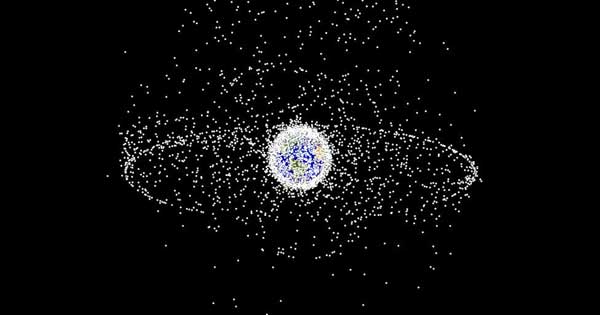
A few days ago, my three-year-old daughter spontaneously cleaned the breakfast table. She scraped cold leftover oatmeal into the rubbish bin, dropped the dishes into the kitchen sink, and wiped down the table. If a three-year-old can tidy up the breakfast mess without being asked, I wonder, why are we humans incapable of cleaning up the masses of space junk we insist on tossing into Earth’s orbit?
Granted, the problem is bigger: items numbering in the hundreds of thousands have been lost—or dumped—into orbit, including an astronaut’s glove, a spatula, and a 1,400-pound tank of ammonia. This trash cache orbiting Earth poses a very real danger to satellites and to the International Space Station. Not only do satellites orbit in different planes, but the direction of the debris’ orbits will change over time, meaning that satellites and trash can collide from almost any direction at velocities of several miles per second. In 2009, for example, the communications satellite Iridium 33 collided with the defunct Russian Kosmos 2251 satellite, generating a giant cloud of more than one thousand pieces of debris, and in April 2012 NASA’s Fermi Gamma-Ray Telescope narrowly missed a crash with another obsolete Russian reconnaissance satellite, Cosmos 1805.
Now, Australian astronomer Steven Tingay hopes to remedy that situation with a space-junk-tracking system based in part on radio waves emitted by local radio stations. Tingay is director of the Murchison Widefield Array (MWA), a low-frequency telescope in Western Australia. The MWA, a highly sensitive telescope exploring the Cosmic Dawn—the era when stars and galaxies first formed in our universe—is constantly surveying vast swathes of sky. Its enormous field of view makes the MWA particularly useful for monitoring space junk as well, since the telescope can simultaneously track hundreds of pieces of debris and follow them to figure out their orbits.
He and Ph.D. candidate Ben McKinley realized that radio waves beamed into space by local FM transmitters bounce off the moon, the International Space Station, and small pieces of junk, which reflect some of them back to Earth, where they can be monitored. The telescope can receive reflected signals from objects smaller than a meter and as far as 1,000 kilometers away. According to NASA, most space junk orbits within 2,000 kilometers of Earth’s surface, with the greatest concentrations found near 750 to 800 kilometers.
The most dangerous pieces of debris, as Tingay wrote to me in an email, are “those that are small enough that they are not well monitored, yet big enough and numerous enough to pose large risks. Even a bit of junk the size of a marble will take out a satellite when it is traveling at a relative speed of [about] 10 kilometers per second.” By tracking the positions of space junk, Tingay and his team can predict when collisions are likely to occur, alerting operators to maneuver their satellites out of the path of the treacherous debris.
The method is “very simple and efficient,” Tingay wrote, because there is no need to coordinate with local radio stations. “We just utilize whatever they are broadcasting.” he says. “That is part of the beauty of this technique.”

